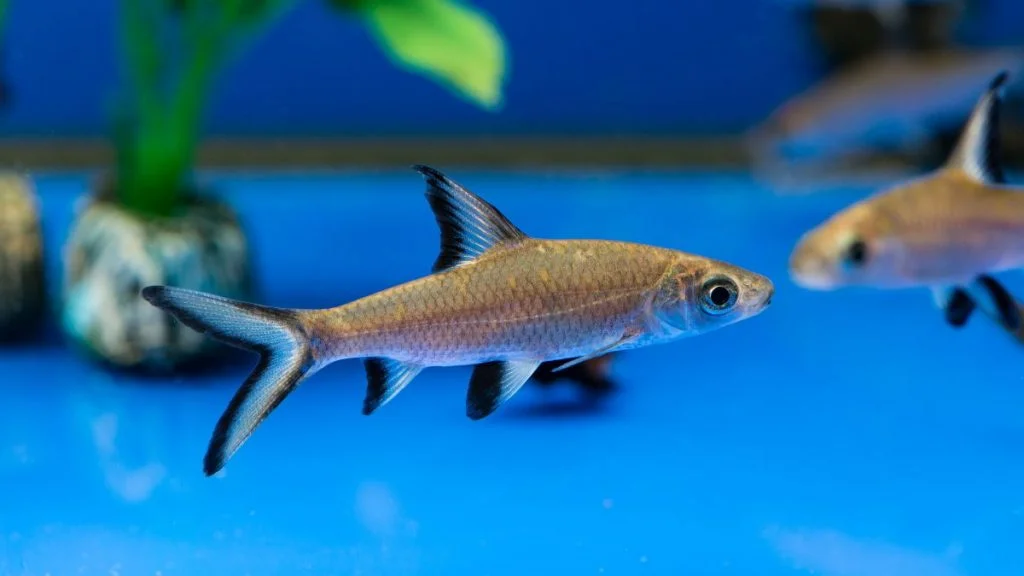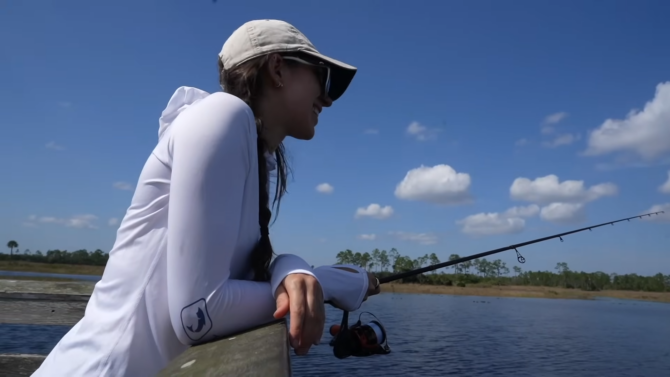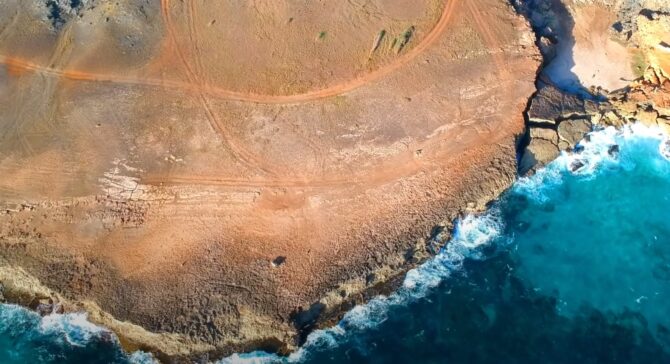From the Cyprinidae family comes the Bala shark fish species. Cyprinidae is a family that regroups barbs, minnows, carps, and barbels.
The Bala shark falls under the minnow category, and despite its name is not a real shark. It was only named so because of its body shape.
For aquarium owners, the body shape is what attracts them to this fish. It is also peaceful and non-aggressive, so owning one is like owning a pacifist shark.
Lovers of actual freshwater sharks that can’t accommodate the fierce predator may find a suitable alternative in this species.
Let’s look more into the different needed information on the Bala shark care, diet, size, habitat, and other facts.
Bala Shark Fish Species Characteristics

| Scientific Name | Balantocheilos melanopterus |
| Common names | Bala shark, hangus, Malaysian shark, silver Bala, silver shark, tricolor shark, tri-color shark minnow |
| Size | 13 inches (35 cm) |
| Lifespan | 8 to 10 years |
| Distribution/Origin | Southeast Asia |
| Color | Silver, gray, yellow, black |
| Diet | Omnivore |
| Behavior | Peaceful |
| Minimum tank size | 120 gallons |
| pH | 6.0 to 8.0 |
| Hardness | 5-12 dGH |
| Care level | Easy to intermediate |
| Tank level | All levels |
| Breeding | Egg-layer |
Bala Shark Scientific Classification
| Kingdom | Animalia |
| Phylum | Chordata |
| Class | Actinopterygii |
| Order | Cypriniformes |
| Family | Cyprinidae |
| Subfamily | Barbinae |
| Genus | Balantocheilos |
| Species | B. melanopterus |
| Conservation Status | Vulnerable |
Origin and Distribution
The Bala shark originated in southeast Asia where it can still be found today. It lives in freshwater rivers and lakes, both medium and large-sized.
It used to be found in regions like Thailand, Borneo, Sumatra, and the Malayan peninsula.
However, this fish is currently vulnerable and rare. In many of the previously mentioned regions, it has become extinct.
What dwindled their population? Experts have pointed out many factors, all of which possibly contributed one way or the other.
Overfishing for aquariums is a primary factor, and the loss of this freshwater species is also tied to the forest fire in 1975.
Dams and pollution are some other factors experts have pointed out that likely led to the pessimistic status of this fish. These days, they can mainly be found in aquariums.
Bala Shark Size and Appearance
The Bala shark has a torpedo-shaped body and a dorsal fin, all of which give it the impression of a shark.
Its body is either silver or gray, and it looks as if it was shaped with metal. The scales stand out, with a tail colored yellow and black fins.
Because of the combination of three colors, the Bala shark is also called the tri-color shark. The scales are iridescent as well, making the fish glow.
This fish has a deceptive size, and if you don’t consider its growth you might end up with an aquarium smaller than the full-size Bala shark.
A lot of fish owners buy the little juvenile at just 3 or 4 inches and are surprised to see the full-grown Bala shark getting to 1 foot when grown.
If your fish tank becomes too small, there are other options you can explore.
Many pet shops don’t accept large fish, so consider some public structures that can accommodate the fish. Whatever the case, do not drop the fish in a waterway.
Behavior
This fish is peaceful and social, so it should be with a minimum of four other fishes of its kind. It shouldn’t be left alone as it gets timid when solitary.
Fortunately, its behavior is nothing like the freshwater shark. The latter isn’t bad, but one can’t compare the freshwater shark with this fish.
The peaceful nature doesn’t make it passive, though. This fish is very active and seems to always be moving, and would often swim other a plant.
Some people mistake the fish’s shyness for dullness, but the shyness only happens when it doesn’t have tank mates.
Bala Shark Gender: Male vs. Female
There aren’t many differences between both genders, except that the female Bala shark may get a round belly when spawning.
Bala Shark Care and Tank Requirements
Given that the Bala shark’s natural habitat is freshwaters, its aquarium has to be filled with the same water like lakes, streams, and ponds.
For this fish to survive and thrive in captivity, the aquarium must be a copy of its habitat out in the wild.
The tank should be big enough for the fish to swim comfortably in, and also accommodate its tank mates. The estimated measurement is 5 feet and 150 gallons in volume.
While some fishes need stones and pebbles to be comfortable in an aquarium, this species doesn’t.
It doesn’t need a lot of plants, but some, like anubias, can make the aquarium home. Because these fishes love to hide in plants, do well to make provisions.
They don’t need a specific type of substrate because they don’t live at the bottom of tanks, but you can find substrates that are close to the fish’s habitat. They’re usually dark, and about ½ an inch thick.
Also, note that Bala fishes dive out a lot. To avoid this, place a lid at the top of the aquarium.
The ideal Bala shark tank should have:
- A neutral, flowing freshwater.
- 150 gallons minimum as size, and 45 gallons for every extra fish.
- The substrates are either pebbles or mud.
- Plants and roots are required.
- The acidity falls between 6.0 to 8.0 pH.
- The water hardness is at 5 to 12 dGH.
- It needs a filter that provided a current similar to the Bala shark’s natural habitat.
- There should be 8 hours of light and a water heater.
Bala Shark Tank Mates
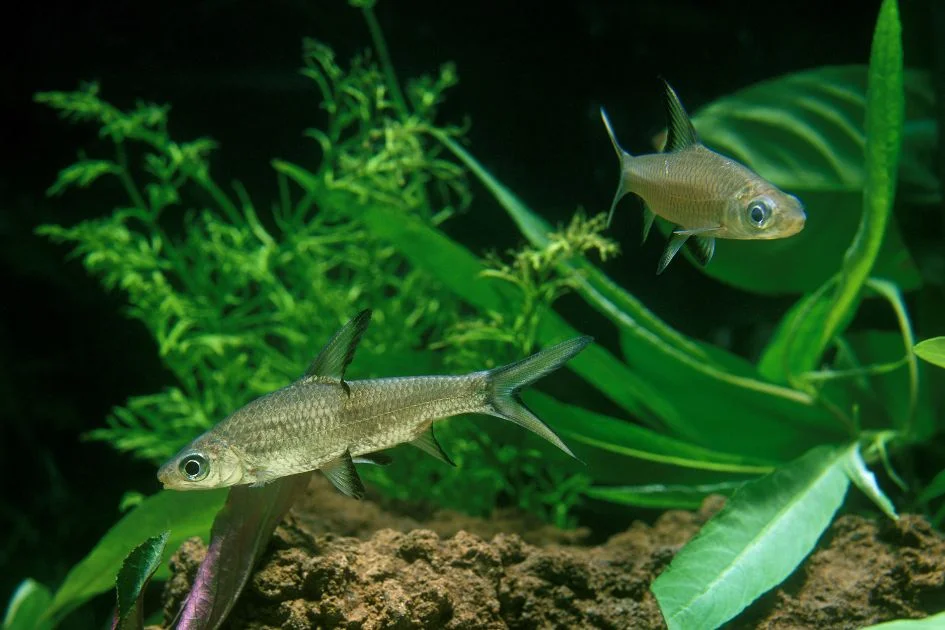
We’ve established that these fish love being around fishes of their kind, but they can also live with other species, especially the peaceful kind.
Do not keep them in the same tank with an aggressive predator fish or a carnivorous one.
They should also be placed with fishes their size as they’re known to feed on smaller fishes. Avoid living them around crustaceans for the same reason.
Slower fishes might find this species too startling, so they don’t make good tank mates.
Here are some fishes that can make good tank mates for the Bala shark:
- Gouramis
- Rainbowfish
- Rasboras
- Corydoras
Bala Shark Diet and Food
What do Bala sharks eat?
This fish is a natural omnivore, and even in captivity, its dietary needs should be similar to being in the wild.
The free-living Bala shark feeds on larvae, plant matter, insects, algae, crustaceans, etc.
In an aquarium, dried foods like flakes and pellets are essential. Go for a high-quality meal, not low ones for health reasons. Its diet should provide enough vitamins, protein, and minerals.
Of course, this omnivorous species also need animal nutrient. Provide live animals like bloodworms and shrimps that contain a high level of protein, and supplement those with some vegetation, plankton, and even fruits.
Do not overfeed this fish as that can affect its size. While it should be fed regularly (three times a day), give the meal in small amounts.
Health
In good conditions, this fish species live healthily and have no illness related to the species.
However, there are freshwater diseases that this species can suffer from due to poor living conditions. They include:
Dropsy
Dropsy often occurs when the fish is infected with a bacteria or parasite.
It leads to an accumulation of fluid in the fish’s body, making the affected fish swollen with protruding eyes.
Dropsy also causes the fish to lose appetite, have breathing problems, and even have scales sticking out more than usual.
Ich
Ich affects a lot of freshwater fishes, so it is as common to them as hip dysplasia is to domestic dogs.
Ich produces white spots on the fish’s skin like rashes produce red spots in humans. Besides the white spots, another symptom of ich is the fish scratching against the tank.
Treatment involves quarantining it inside warmer water and a little salt (1 teaspoon per gallon of water).
External parasites
As the name shows, external parasites come from other sources.
For the Bala in captivity, these parasites could be introduced into their aquarium from live foods, plants, and any new tank mate you bring in. These parasites then attach to the body or gills of the fish.
Treatment involves insecticides and medication from a vet. Filters often come with activated carbon media which should be removed while administering treatments to the aquarium.
Breeding Bala Sharks
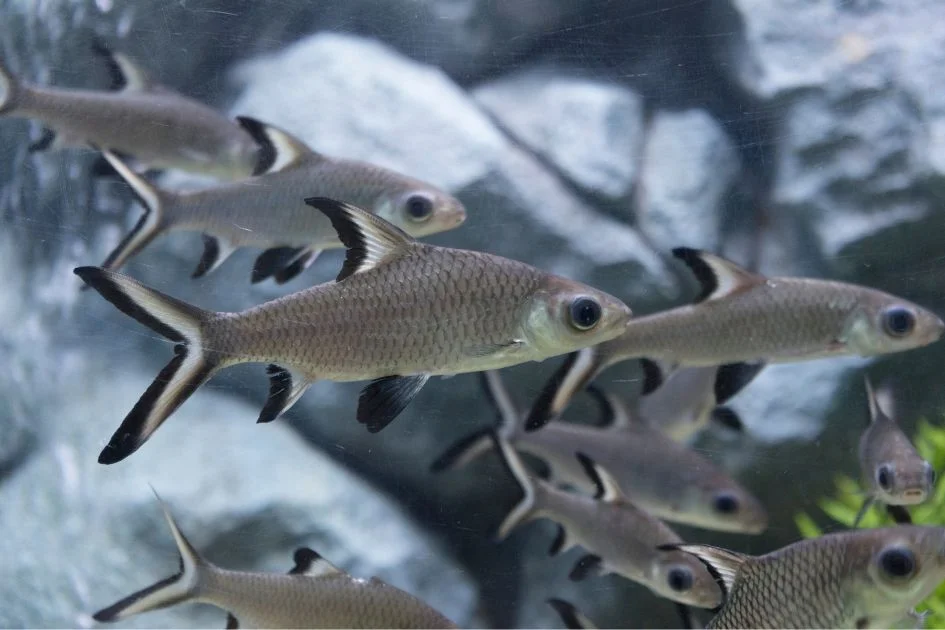
The Bala shark isn’t easy to breed, and it has not been successfully bred in a home aquarium (though there might be some exceptions).
First-time aquarists need not apply as breeding this fish species is for those with experience.
The first thing to know when breeding Bala sharks is when it gets mature. That often happens around 6 months, or when the adult Bala shark has grown to 4 inches.
After that, there are some steps you can follow to breed a Bala shark:
- You’ll need a breeding tank of about 65 gallons at a temperature of 77° F, a good filter, and a breeding net for the eggs.
- Put a group of 5 Bala sharks into the tank. While breeding can easily be done with 2 members of the opposite sex with other animals, it is difficult to do that with the Bala shark because of the little difference between the male and female. When you put in 5, there’s a bigger chance of a male and female being within.
- Set the mood by increasing the water temperature to 85°F over one week. This initiates spawning, and you’d know it worked once you notice some Bala sharks getting rounder. Spawning often occurs early in the morning and can last for hours.
- When the female lays the egg in the breeding net, the male does the job of fertilizing it with milt.
- After the fertilization, remove all the adult fishes from the tank to prevent them from eating the eggs. Also, replace the filter with a sponge filter that won’t suck up the eggs.
- Change half of the water (50%) and use antibacterial solutions.
- Larvae should start appearing within 24 hours and the egg should hatch within 3 days. You can feed the little Bala shark ciliates, then nauplii or cyclops.
- The little ones should remain in a separate tank till they get to six months or 4 inches, the sexual maturity period.
Should You Get a Bala Shark for Your Aquarium?
Bala sharks are good for aquariums, but that doesn’t mean they’re fit for everyone.
They are very active and will keep you entertained for a long time, but can become challenging if you don’t have the right living conditions and experience.
For beginner fish owners, many experts agree that Bala shark care is somewhat easy if you have some basic knowledge of fish care.
To own this fish, you need a large aquarium that can contain at least five adults.
Once again, do not keep this fish with other predatory fishes, crustaceans, and small fishes. Also, do not own one if your aquarium is too small.
Frequently Asked Questions (FAQs)
How long do Bala sharks live
With proper care, the average lifespan of a Bala shark is between 8 to 10 years.
How big will a Bala shark get?
The adult Bala shark grows up to 1 foot or even more. This is a sharp contrast from its young age when it is just 3 to 4 inches.
Is the Bala shark a real shark?
Although the Bala shark has the structure of a shark, and it was named so, it is not a real shark, but a minnow.
What size tanks do Bala sharks need?
Bala sharks should stay in a large aquarium with enough space to move around, especially as it is social and stays around other fishes. It should measure up to 5 feet with a volume of at least 150 gallons.
Final Thoughts
Owning a home aquarium can be fun, and while it is difficult to breed a Bala shark at home, you can get one and have the experience of taking care of it.
They need peaceful company, but not the kind they can eat. If you can get many of Balas (like 5), that could help.
Proper feeding and a good, spacious environment are necessary for its well-being.
Featured Image Credit: fudfoto / Getty Images
